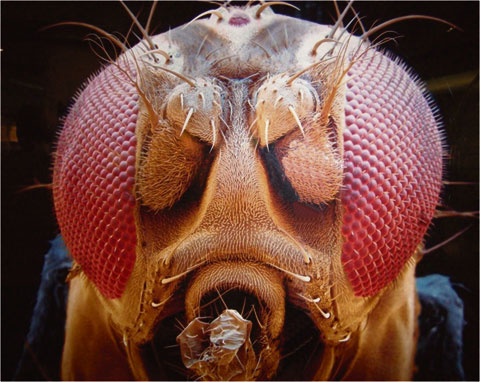Mukul Sarkar developed a CMOS image sensor that functions like the compound eye of an insect. Insects have a very blurred view of their surroundings, but their compound eyes detect movement and the polarization of light very accurately, allowing them to fly and navigate with very limited intelligence.
According to Mukul Sarkar, these advantages make an insect’s visual system very useful for robotics.
Sarkar, who conducted his research in Delft ( EEMCS faculty) and at the Holst Centre, a sensors and electronics research institute in Eindhoven, will defend his Phd thesis, entitled ‘A biologically inspired CMOS image sensor’, on Friday, February 4.
“Light emanating from reflections is partially polarized,” Sarkar says. “Because insects have their light-sensitive rhodopsin molecules nicely aligned in their faceted eyes, they’re able to detect the polarization. This information for example tells them what type of substrate they’re looking at, since all materials polarize the reflected light differently.”
Insects also use the angle of polarization as a navigation tool – as a kind of light compass. And they need very little brain processing power to do this. We humans on the other hand, with our polarisation blind eyes, must compare different high resolution images with one another and calculate the changes in x, y and z directions in order to estimate movements, which is much more complicated.
“The same goes for robots that use photodiodes for their vision and navigation,” Sarkar explains. “They need to perform iterative processes with multiple images, which costs lots of energy. If we provide them with CMOS image sensors capable of in-pixel polarization detection and data processing power, we solve that problem.”
By neatly aligning the metal wires in a CMOS sensor – the wires that are used for routing in the chip – Sarkar developed a sensor with grids that only allow light with certain polarisation to penetrate. Each sensor is composed of four pixels. The wires on top of each one of the pixels are laid down in a different direction, making each pixel sensitive to different polarization.
There is still a lot of work to be done to obtain high enough resolution, but Sarkar believes these types of sensors could one day be used in endoscopes: “Cancer tissue reflects light with different polarisation than healthy tissue. A small chirurgical robot could use this information to navigate towards the tumor.”
Twijfels heeft Bosschaart niet. Hij is ervan overtuigd dat zijn partij er alles aan gedaan heeft om de studentenbelangen goed te behartigen. Met slechts twee fulltime medewerkers was dat echter een onmogelijke opgave. “Hoewel we ons uiterste best doen en alle middelen uit de kast hebben getrokken, vervullen we een marginale rol in de studentenraad. We bereiken te weinig van onze doelen.” De beslissing van AAG komt niet onverwacht. Keuzes voor specialisaties als duurzaamheid en onderwijs en de oprichting van schaduwfracties met parttimers, leverden dit collegejaar en in het verleden niet de gewenste resultaten op. Al eerder trok de partij zich een jaar terug om zich volledig te richten op promotie. Na terugkomst bleek de situatie nog hetzelfde. Tegenspeler Oras kreeg acht zetels en voor AAG bleef het bij twee zetels. In ongeveer zeven jaar tijd zag de partij het aantal zetels flink dalen. Na drie jaar met twee zetels is de maat vol. “Je kunt niet aan een dood paard blijven trekken.” Gesprekken met Oras en het college van bestuur leverden onvoldoende garanties voor continuïteit. “We stellen hun handreikingen op prijs, maar ze waren niet toereikend.” AAG dient dit collegejaar nog uit en richt zich vooral op de bezuinigingen, het proces van herijking en de kwaliteit van het onderwijs. Bosschaart vindt het jammer als er in mei niets te kiezen is. “Met nog maar één partij wordt dat erg lastig. Misschien is het toch tijd om na te denken over de toekomst van het huidige meerpartijenstelsel. Daar geef ik graag mijn mening over, maar wel op een ander moment.”



Comments are closed.